ARTICLE
Introducing The Blake Model
The present project arises from my effort, over the years, to hone a concise explanation of Blake’s mythology to myself, my colleagues and my students.*↤ For their feedback and assistance with this project I am indebted to Sandy Baldwin, Joshua David Gonsalves, Stephen Harris, Adam Horne, Jeremy Jarrell, Wayne Ripley, Frances Van Scoy and Susan Warshauer. As a diagram junkie, I have several schemata at my disposal,**↤ For further reflections on the project described herein, see Adam Komisaruk, Steve Guynup and Fred Yee, “Blake and Virtuality: An Exchange,” Digital Designs on Blake, ed. Ron Broglio, Romantic Circles Praxis Series, forthcoming <http://www.rc.umd.edu/praxis/>. including Alicia Ostriker’s chart of the zoas and their attributes from the Penguin Complete Poems (illus. 1); Northrop Frye’s earlier and more extensive version from Fearful Symmetry (illus. 2); S. Foster Damon’s map of Golgonooza, the city of art, from The Blake Dictionary (illus. 3); or my own family tree of Blake’s cast of characters (illus. 4).1↤ 1. All my Blake quotations are from The Complete Poetry and Prose of William Blake, ed. David V. Erdman, newly revised ed. (New York: Anchor, 1988), hereafter “E.” Where each of these schemata falls short, however, is in its inability to represent fully the spatial extent of Blake’s vision. Damon himself says in a footnote to his diagram, “Golgonooza, being four-dimensional, cannot be reduced to a chart of two dimensions. Each of the four gates not only opens into each of the other gates but does so ‘each within other toward the Four points’ (J[erusalem] 12:48)” (163). Thus about four years ago the idea occurred to me of developing a physical model that could visualize Blake’s
Supported by internal grants from West Virginia University, in collaboration with the Virtual Environments Laboratory there, and with an eye to future funding by the National Science Foundation’s Information Technology program, I am breaking the project into the following phases: (1) the creation of the overall landscape or Blakean universe; (2) the creation of a human figure corresponding to Blake’s Albion, who is the chief occupant of this landscape; (3) the decision as to what in the landscape goes where; (4) the animation of this environment to make it traversable by users and to show its transformations through time; (5) the creation of a user-friendly interface; (6) the preparation of textual annotations for the objects, locations and characters in the environment.
Blake’s landscape, at its most basic, consists of the four levels of existence with which readers are already familiar—Eden, the redeemed realm of pure spirit; Beulah, the sensual paradise; Generation, or vegetative life without consciousness; and Ulro, or dead matter. I will be representing these realms as four concentric spheres, since for Blake the Fall involves a contraction toward a center, not just a longitudinal descent. Between Ulro and Eden extends the “Mundane Shell,” a large egg-shaped object that encloses the material world. Ulro, the lowest or inner-most realm, is where the majority of human history transpires and is therefore wrought by Blake in the most detail. Using the digital modeling program Bryce 3D (Corel), I made a preliminary attempt (illus. 5) to represent the rocky expanse of Ulro, begin page 94 | ↑ back to top including the forest of Entuthon-Benython and, within it, the lake of Udan-Adan and the great city of Golgonooza. Inside Golgonooza stands Bowlahoola, workshop of the artist-black-smith Los, and the hall of Cathedron. Bryce 3D is a relatively user-friendly but inflexible program; subsequent modeling will be done in industry-standard programs such as Maya (Alias) or 3D Studio Max (Discreet). I am fortunate to be assisted in the landscaping phase of the project by the talented New York artist Fred Yee, who has prepared a wonderful storyboard that he will soon be realizing digitally. Yee worked without the benefit of Blake’s images, only his texts, yet the two artists’ visions have some striking parallels. Take, for example, Blake’s sketch of Cathedron in the margin of the Four Zoas manuscript, Night the Third (illus. 6); the crown on her head and gothic altar for her genitalia suggest Blake’s association between female sexuality and the established church. Yee’s realization
I would like to step back from this level of detail, which resides rather far off in The Blake Model’s future, and return to the bigger picture. As I said, the first task is to create the four concentric spheres that represent Blake’s levels of existence, and the Mundane Egg that stretches between them. Primitive shapes of this kind may be digitally generated with relative efficiency. The second task is to create the principal character who will inhabit this environment—Albion, the eternal man whose body serves as the microcosmic map of Blake’s macrocosmic universe.2↤ 2. Technically, Albion himself is both microcosm and macrocosm: the universe is mapped out on his body, but his body is also positioned within this universe, which in turn is mapped out on his body, etc. To create this mise-en-abyme effect, The Blake Model will be programmed with a simple loop, so that zooming in on Albion eventually returns the user to a bird’s-eye view of Albion. Stephen Guynup captures something of this idea in his virtual rendition of Blake’s “The Crystal Cabinet,” which envisions “Another England” within England; with Ron Broglio and Thomas Tulis, “William Blake’s ‘Crystal Cabinet,’” January 2003 <http://www.pd.org/~thatguy/crystal/index.html>. Unlike the denizens of Ulro, Albion must be
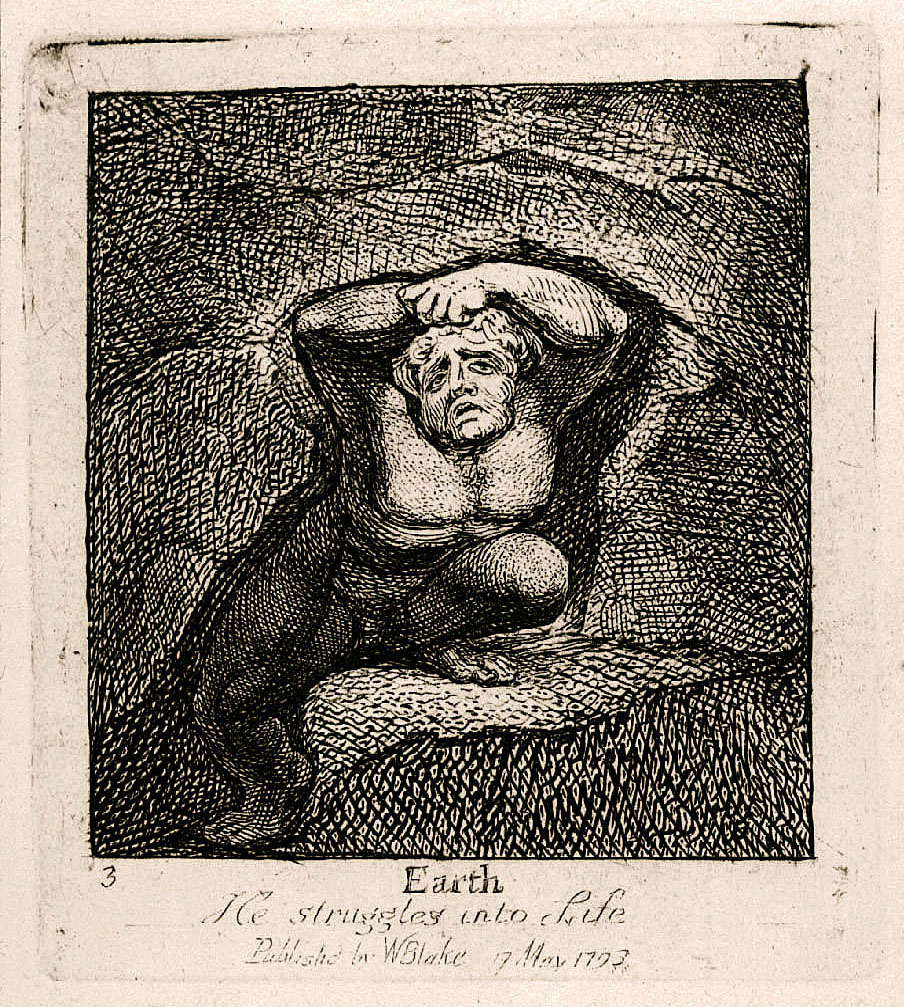
[View this object in the William Blake Archive]
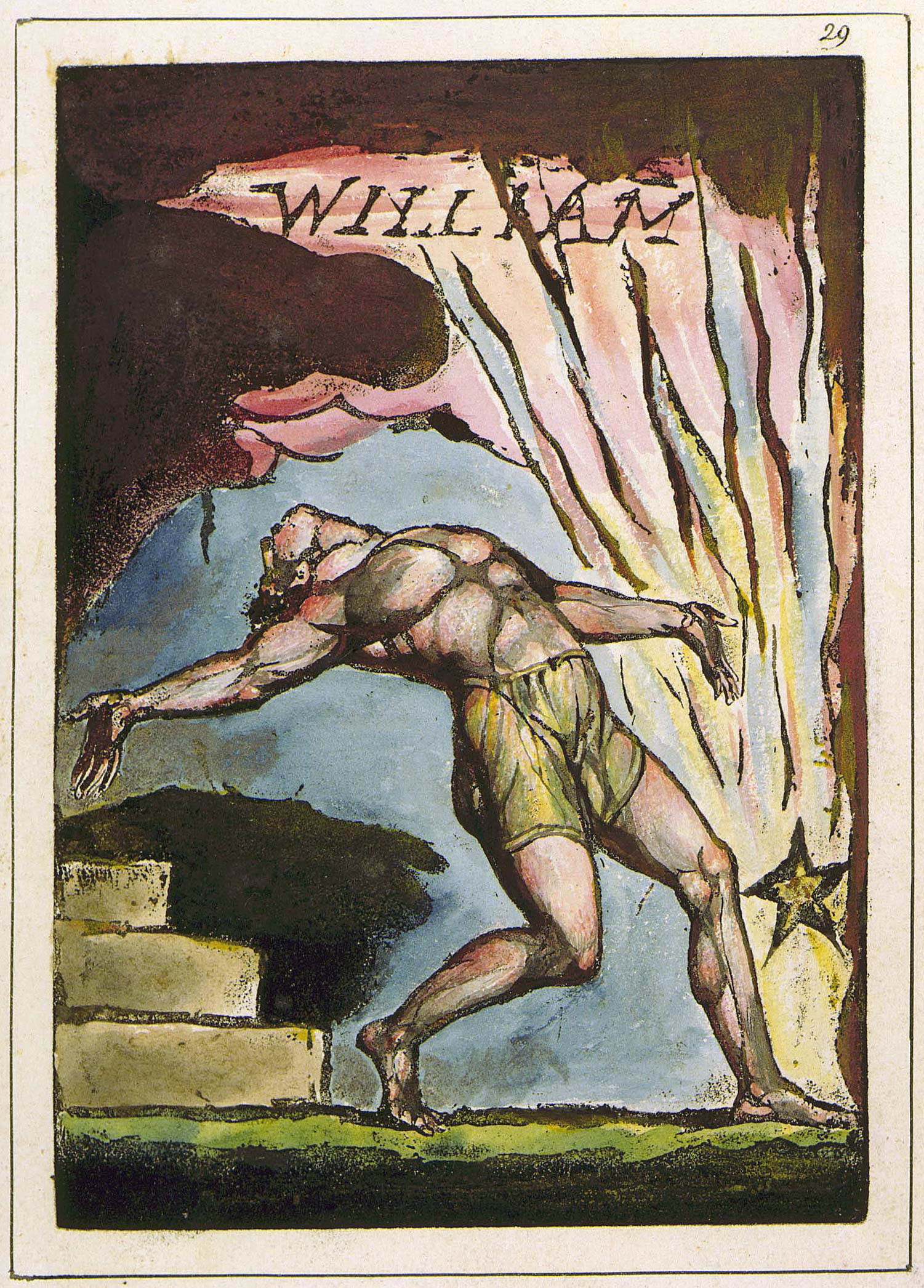
[View this object in the William Blake Archive]
The third task, that which requires the most literary research, is to position this human figure within the landscape according to Blake’s complicated but precise spatial instructions. We recall that each of the four “compass points” is the seat of a different faculty: Urizen, reason, resides in the south; Luvah, love, in the east; Tharmas, sensation, in the west; and Urthona, instinct, in the north. At times Blake’s directionals are fairly straightforward, as in the famous diagram of the zoas from Milton (illus. 12), or the following lines from Jerusalem: “And the Four Points are thus beheld in great Eternity / West, the Circumference: South, the Zenith: North, / The Nadir: East, the Center, unapproachable for ever. / These are the four Faces towards the Four Worlds of Humanity / In every Man. Ezekiel saw them by Chebar’s flood” (12:54-58; E 156). At other times, however, Blake is considerably less intuitive. It is especially difficult to work out how the four compass points of the universe correspond to the four compass points on the body of Albion, which is a microcosm of the universe, and in turn to the four compass points on the face of Albion, which is a microcosm of
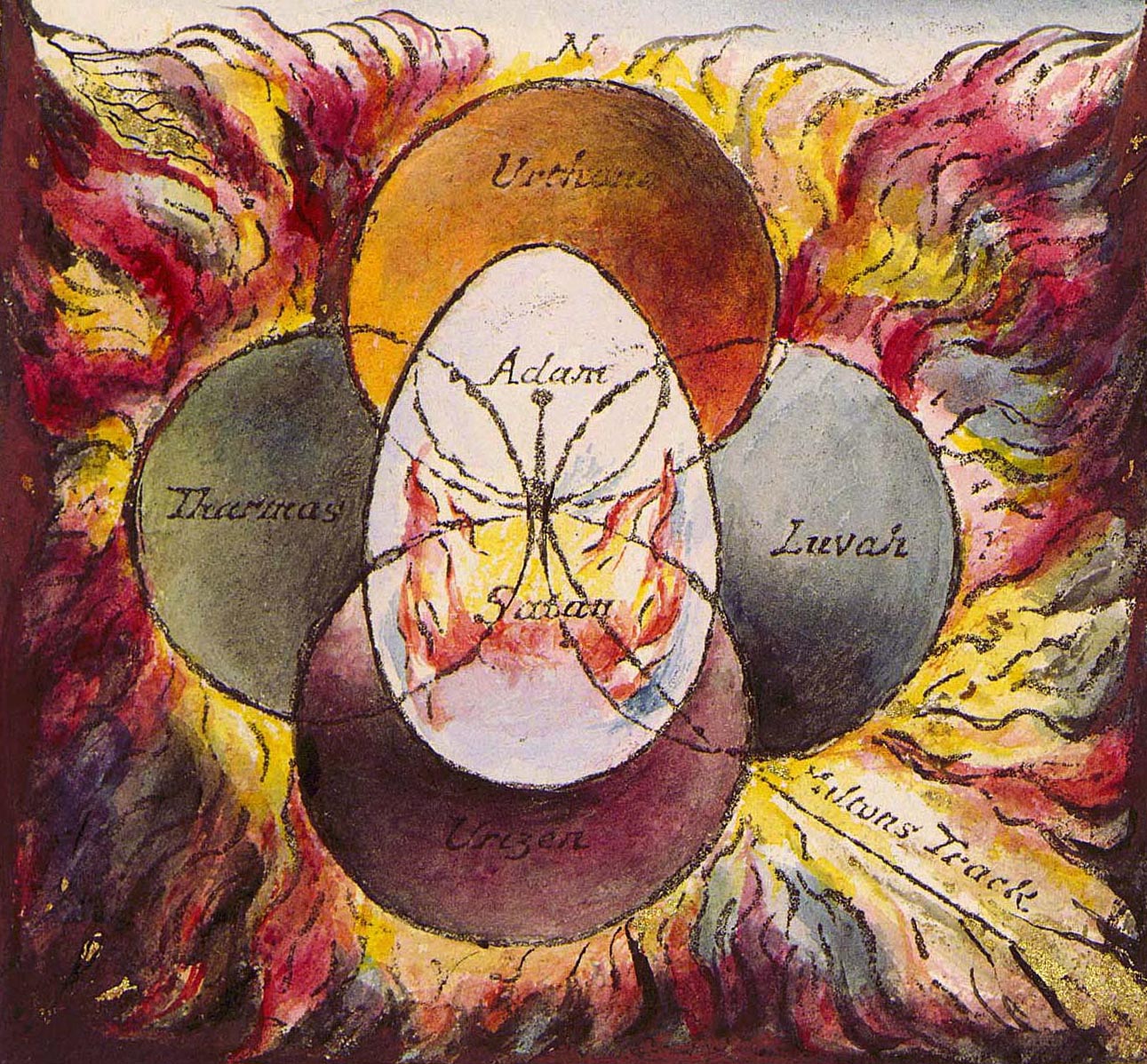
[View this object in the William Blake Archive]
The goal of phases four and five of the project is to create smooth-scrolling graphics responsive to user intervention. “First-person shooter” video games will provide the visual metaphor; indeed, The Blake Model will probably use one of the open-source animation engines written for those games, such as Unreal (Epic Games), Quake (Id Software) or VRML. I would also like to have preprogrammed animation sequences that will reenact major events in Blake’s mythology, such as the fall of Albion from Eden to Ulro, the 90-degree rotation of the zoas during the fall, and Milton’s track across the cosmos. The interface will include separate viewports for the landscape and for the object annotations, which I will discuss later, as well as navigational buttons to rotate, zoom and pan. I will probably accomplish these tasks with the cooperation of WVU’s Geographic Information Systems (GIS), using the program WorldToolKit (Sense8).
To illustrate how such an animated sequence might work, and help to gloss a particularly cryptic Blake passage, I refer to the “vortex” metaphor from Milton:
The nature of infinity is this: That every thing has itsIn the “vortex” routine (illus. 15), the user begins with a Milton’s-eye view, hovering in Eden [a]. Because Blake’s four realms of existence are represented as concentric spheres, the globe below describes the boundary between the purely spiritual Eden and the beginning of matter in Beulah. The outstretched hand, a familiar icon in first-person-shooter games, begin page 98 | ↑ back to top corresponds to Milton; it is transparent at this point because Milton’s spiritual body has not yet assumed its physical cloak. As Milton descends [b], Albion appears in a holographic projection of his eternal state. Being fallen, Albion is not actually present in Eden, as becomes apparent when Milton tries to move closer [c]; the landscape scrolls past and the ground approaches, but Albion remains a few steps beyond Milton’s reach. When Milton touches down in Beulah, another figure appears [d]—it is the bodily form of Milton, which Milton must assume (by passing through it) so that he may receive admittance to the lower realms. Milton’s incarnation is signified when the second figure disappears, leaving only the Albion-holograph; the transparent arm at bottom becomes opaque [e]. Milton continues his descent from Beulah to Generation, then Ulro, whose unregenerate nature is indicated by a rocky landscape. As he approaches this source of the holographic projection, Milton begins to see the fallen rather than the ideal state of Albion: Albion’s posture gradually changes from erect to supine, and his body acquires the same fleshed-out tones as Milton’s arm [f]. Before long, however, Milton must shed his physical cloak once more in preparation to greet Albion as a redeemer; the arm becomes transparent again and, off to one side, Milton’s body reappears [g]. By now, Milton can actually catch up with Albion, and so bends “down / To the bosom of death,” passing directly through the couchant Albion’s heart and out the other side [h]. Milton has now crossed Albion’s “vortex.” Continuing to move in the same direction while swiveling around to look behind, “what was underneath soon seemd above”; Milton sees the fetal-like Albion receding into the distance [i].
Own Vortex; and when once a traveller thro Eternity.
Has passd that Vortex, he percieves it roll backward behind
His path, into a globe itself infolding; like a sun:
Or like a moon, or like a universe of starry majesty,
While he keeps onwards in his wondrous journey on the earth
Or like a human form, a friend with whom he livd benevolent.
. . . . . . . . . . . . . . . . . . . . . . . . . . . . . . . . .
First Milton saw Albion upon the Rock of Ages,
Deadly pale outstretchd and snowy cold, storm coverd;
A Giant form of perfect beauty outstretchd on the rock
In solemn death: the Sea of Time & Space thunderd aloud
Against the rock, which was inwrapped with the weeds of death
Hovering over the cold bosom, in its vortex Milton bent down
To the bosom of death, what was underneath soon seemd above (15:21-27, 36-43; E 109-10)
The user’s perspective now switches from Milton’s-eye view to an exterior view, where Albion’s existential range is represented as a gigantic cone [j]. The cone opens up toward Albion’s infinite state, to which he will eventually return; its tip corresponds to his present, most narrowly contracted state; the speck below the tip is Milton. The cone swings around so that it opens away from the viewer, who looks straight down the tip; the foreshortened cone appears as a globe [k]. The user thus, it is to be hoped, apprehends Blake’s image: every
The sixth and final phase of the project is to annotate the model with embedded hyperlinks to selected Blake texts, images and critical glosses. For example, clicking on the Cathedron object in the landscape might spawn a pop-up window with a short definition and links to related terms (illus. 16). One may also read a relevant passage from Jerusalem, look at the original drawing from The Four Zoas or sample classic commentary from Frye or others. I hope to link the poetry excerpts to existing internet resources such as the William Blake Archive at the University of Virginia, where users could avail themselves of additional tools such as search forms and a Blake concordance; or the Blake Digital Text Project at the University of Georgia, which, like the Archive, offers the entirety of David Erdman’s standard edition online.4↤ 4. Blake Digital Text Project, ed. Nelson Hilton <http://www.english.uga.edu/wblake/home1.html>; William Blake Archive, ed. Morris Eaves, Robert N. Essick and Joseph Viscomi <http://www.blakearchive.org>.
After The Blake Model is complete, it should fit onto a single CD-ROM and be viewable by anyone with a suitably appointed personal computer, with or without an optional immersion device such as the CAVE or ImmersaDesk. Once begin page 99 | ↑ back to top debugged and revised according to a detailed user questionnaire, it will be made available as an open-source download from the WVU English Department website. As for the future directions of the project, I foresee a series of Literary Models that extend the 3D-imaging concept to several other writers who think “spatially” or “geographically” and who, not coincidentally, stand in the chain of influence alongside Blake. A Dante Model would take the user on a visual tour of the circles of Hell, the mountain of Purgatory and the reaches of Paradise as described in the Divine Comedy. A Faerie Queene Model could help keep straight the complex narrative and immense cast of characters in Spenser’s romance. With a John Milton Model, the user would re-enact Satan’s travels in Paradise Lost, from his fall from Heaven to his entrance into the Garden of Eden. A James Joyce Model could present a “virtual Dublin” in which the user navigates through the locations and events described in Ulysses.
In the remainder of this essay I would like to address some of the conceptual problems that I see arising from The Blake Model, not so much the project’s technical challenges as its implications for the study of Blake. The first is the somewhat hoary question about the appropriateness of teaching with technology, especially given Blake’s own suspicion of alienated labor. My technophilic streak vies with my Luddite anxiety that I may be hastening my own obsolescence, propelling the dark Satanic mills of the wired classroom. Cyberspace is a real space, an advertising space that the private sector leases in a diabolical bargain with a cash-starved public education system; ironically it is here that The Blake Model makes a space for itself. Electronic transposition does not confer immortality on the text or insulate it from the elements of production, as Mary Lynn Johnson found in her short-lived Iowa Blake Videodisc Project: “we did not take an active enough hand in the care and feeding of our newly weaned prodigy.... even files in storage require eternal vigilance.”5↤ 5. Mary Lynn Johnson, “The Iowa Blake Videodisc Project: A Cautionary History,” The Wordsworth Circle 30.3 (1999): 132-33. The status of technological labor in the academy also remains controversial, an issue addressed by the authors of the DVD-ROM project Red Planet: Scientific and Cultural Encounters with Mars.6↤ 6. Helen Burgess, Jeanne Hamming and Robert Markley, “The Dialogics of New Media: Video, Visualization, and Narrative in Red Planet: Scientific and Cultural Encounters with Mars,” Eloquent Images: Word and Image in the Age of New Media, ed. Mary E. Hocks and Michelle R. Kendrick (Cambridge, MA: MIT, 2003) 61-88.
While I cannot fully explore here the political ramifications of my medium, I would suggest that such questions were not unknown to Blake himself. The editors of the William Blake Archive, responding to allegations that the project imposes a Urizenic monologism on Blake’s texts, remind us of the assumption “that Blake somehow exempted himself from the unpleasant realities of labor and commerce. But in fact he sold his works for real cash money that he accepted.”7↤ 7. Morris Eaves, Robert N. Essick, Joseph Viscomi and Matthew Kirschenbaum, “Standards, Methods and Objectives in the William Blake Archive,” The Wordsworth Circle 30.3 (1999): 142. The essay is a response to Andrew Cooper and Michael Simpson, “The High-Tech Luddite of Lambeth: Blake’s Eternal Hacking,” The Wordsworth Circle 30.3 (1999): 125-31. Cooper and Simpson respond to this response in “Looks Good in Practice, but Does It Work in Theory? Rebooting the Blake Archive,” The Wordsworth Circle 31.1 (2000): 63-68. Viscomi, in his study of Blake’s technique, argues that efforts to place Blake beyond the reach of finance are ahistorical, misinformed by a book-publishing rather than print-publishing paradigm: ↤ 8. Joseph Viscomi, Blake and the Idea of the Book (Princeton: Princeton UP, 1993) 172.
Instead of perceiving illuminated printing as a reaction against—or an effort to reject—“conventional taste” or the “commercial bourgeoisie,” we need to see in it Blake’s desire to tap into a market created by the status quo’s demand for drawings, a market actively supplied by commercial and original printmakers. . . . Like etchings and facsimiles of sketches, they [Blake’s illuminated prints] move toward the simple and spontaneous, toward drawing, and away from the overtly skillful performance characteristic of reproductive engraving. But this move away from the reproductive ideal does not make them “subversive,” except to purists . . .; to collectors of the day, illuminated prints may have represented Blake at his most fashionable.8How many copies of his illuminated books Blake produced at any given session “appears to have been determined by such practical concerns as how much paper the Blakes could afford for each book, as well as by such material concerns as how many books could be produced per quire of paper” (156). Viscomi also disputes certain notions of Blake as a technical innovator who sidestepped the trap of alienated labor:
First, Blake’s control over production was not as complete as imagined, given Mrs. Blake’s assistance in printing and coloring impressions. Second, even if it were, it would not necessarily be politically significant or signify a desire to escape the division of labor characteristic of commercial graphics or letterpress printing. This is because an artist (as opposed to a writer) accustomed to controlling all stages of labor in the production of original prints . . . is not really varying his practice or controlling more of his labor by using a new technique or by producing prints with words. (173)In short, Blake likely harbored few illusions about either the fallen status of commerce or the impossibility of escaping it. His focus may rather have been on working within this system to do some good. Accordingly, the limitations of a Blake-studies technology is not reason to dismiss out of hand its potential for widening and democratizing Blake’s audience. The editors of the William Blake Archive caution against the presumption “that purity of principle on intellectual grounds begin page 100 | ↑ back to top is preferable to accessibility for the general user” (Eaves et al. 141); Karl Kroeber celebrates the Archive for presenting Blake’s calligraphy in its “examinable detail” and for thereby facilitating an “intimate, even necessary, interconnection between intensely specialized research and socially useful teaching at elementary levels.”9↤ 9. Karl Kroeber, “The Blake Archive and the Future of Literary Studies,” The Wordsworth Circle 30.3 (1999): 123, 125. I would similarly point to ways in which my department has used technology to improve access education among underserved communities in rural West Virginia.10↤ 10. See, for example, initiatives of the Center for Writing Excellence, such as the Scott’s Run Writing Heritage Project, 2002 <http://www.as.wvu.edu/~srsh/>; the Distance Learning Program, 2002 <http://www.as.wvu.edu/english/cwe/distance.html>.
My second concern is the inevitable amount of guesswork involved in fleshing out The Blake Model’s features. It is one matter to implement Blake’s instructions for, say, the 64,000 each of fairies, gnomes, genii and nymphs guarding the gates of Golgonooza; the challenge here is one of scale and not interpretation. It is another thing entirely to extrapolate, say, the body language of Albion, on which the integrity of The Blake Model depends. I am mindful that my quest for authenticity, to present Blake as he “really” is, leads me into deeper and deeper layers of conjecture. This is the phenomenon that Jay David Bolter and Richard Grusin observe in many new media, which ↤ 11. Jay David Bolter and Richard Grusin, Remediation: Understanding New Media (Cambridge, MA: MIT, 2000) 19.
[l]ike other media since the Renaissance .... oscillate between immediacy and hypermediacy, between transparency and opacity.... Although each medium promises to reform its predecessors by offering a more immediate or authentic experience, the promise of reform inevitably leads us to become aware of the new medium as a medium. Thus, immediacy leads to hypermediacy.11This paradox, say Bolter and Grusin, explains the lengths to which high-tech media go to simulate low-tech. Thus, the graphical user interface (GUI) “remediates” the office desktop; the web page, the tabloid newspaper; digital graphics, perspectival painting and photography; and virtual reality, film and television (23,69,115,161). Moreover, “just as there is nothing prior to the act of mediation, there is also a sense in which all mediation remediates the real” (59).
Blake himself was an adept remediator. Viscomi points out that Blake’s “facsimile is of the drawing process and not of an actual drawing or model” (26).12↤ 12. “By rejecting [Ruthven] Todd’s theory of transferred texts,” Viscomi himself recognizes that he is remediating “the nineteenth-century theory [of Blake’s technique], in which a ‘preliminary drawing’ of a plate, or ‘illustrated song,’ is reproduced in ‘facsimile’ by being redrawn directly on the plate with the same tools used to execute the originals” (26). Blake could further immerse himself in the factitiousness of his process, as when giving directions for executing a “woodcut-on-pewter” or a “woodcut-on-copper.”13↤ 13. See Robert N. Essick, William Blake: Printmaker (Princeton: Princeton UP, 1980) 160-61; also Viscomi 68-69. Morris Eaves suggests that such deferral of the “original” may be a therapeutic act: ↤ 14. Morris Eaves, The Counter Arts Conspiracy: Art and Industry in the Age of Blake (Ithaca: Cornell UP, 1992) 248.
blurring may be to sight what distance is to immediate impressions—a way of attaining, paradoxically, greater clarity and unity. As Gilpin indicated, reproductive engraving may be a beneficial extension of the process: an additional medium, like another language, affords a new opportunity to generalize and thus improve the original. An engraving may, as many spokespeople for the trade maintained, have its own special dignity not as a copy but as a translation.14Yet bound up with this optimistic view is Eaves’ rather different assertion of Blake’s distrust of mediation: Blake’s technique, as against the English-school ideas of “Gradual, systemic improvement,” is “technologically so regressive . . . that it comes close to opposing tools and materials per se.... [it] seeks to lessen the distortions of time and space by finding the most immediate communication between artist and viewer and the shortest path between mind and matter” (184). If I may try to unite these two strands in Eaves, I would argue that while Blake knows something is always lost in the translation from the prototype that exists in only in his mind, he knows equally that the situation cannot be otherwise.
Indeed, this sense of loss is integral to Blake’s art. Appropriately, his alter ego in the myth is Los (loss), whose oft-quoted dictum, “I must create a system or be enslav’d by another man’s,” savors of Urizenic drudgery. Los may not wish to give up his enormous labors, but neither can he transcend the futility of trafficking in fallen forms within the very bowels of the fiery furnace. He builds the golden city of art, Golgonooza, in the hope that it may reach back to the Eden from which he himself will be forever barred; his most redemptive act is a self-immolation in imitation of Christ that has nothing to do with his art. As if to remind us that visualization is always a concession, Blake frequently frustrates the eye. When we look to the margins of his page for illustrations of the text, we rarely find what we’re looking for, and usually we don’t know precisely what we’re looking at. Depictions of the major characters in the myth, especially in their eternal state, are strikingly difficult to come by. Blake will show us how the zoas manifest themselves in the fallen language of everyday life but not always show us the zoas themselves. Corrupted Urizen appears with regularity, redeemed Urizen less often; we see Urthona after he turns into Los, but seldom before; and does anyone know quite what Luvah or Tharmas looks like? My nagging suspicion that I am doing violence to Blake’s vision by attempting to represent the unrepresentable—do I lead my students to believe a lie when I see not through the eye, but too much with the fleshly eye, reducing what is clearly a symbolical begin page 101 | ↑ back to top language to Newtonian geometry? does my search for a comprehensive model smack of Sir Joshua Reynolds and his gang of cunning hired knaves?—this suspicion recapitulates a concern that pervades Blake’s works qua works. I am not vain enough to compare myself to Blake or Los, nor an ambitious enough revisionist to experience an anxiety of influence under their wings. I would suggest, however, that the oxymoron of a “Blake model” may serve as a very Blakean reminder of the provisional, the transitional nature of all representation. Accordingly, The Blake Model will seek to remind its user of its difference from the “original” at every juncture: its visual idiom should evoke Blake’s watercolors wherever possible, but its overall effect should be schematic rather than Hollywood-verisimilar. The Blake Model is not to be Blake, any more than the high-resolution scans at the William Blake Archive are Blake, or any more than Fred Yee’s sketches are Blake as they quickly take on a life of their own, or any more than Blake is identical to himself, as his texts’ indeterminacy from copy to copy sedulously defies mass production.
The lattermost point is contested. Viscomi warns that Blakeans who fetishize difference may overinterpret the variations in the plates and, again, ignore the material realities of the print trade.
[W]hile designs as initially drawn on plates do differ from the designs as printed, and prints do differ one from the other, such variations do not signify a rejection of uniformity and all it supposedly represents, nor do they determine the print’s meaning. The first kind of difference was inherent to a mode of production in which finishing was conceived as part of the inventive process, and the second kind—for example, the varying width of a river in a particular image—requires comparisons that Blake could not have expected or intended his readers to make. (175)—since Blake produced his illuminated books not one by one but in small editions or sessions sometimes years apart. One may still posit an “ideal copy,” if only within each edition or run of an illuminated book (179). Unfashionable as Viscomi’s unitary vision might appear at first, surely some faith in authorial intention underlies all Blakeans worth their salt—even so committed a postmodernist as Ron Broglio anchors his “digging” expeditions in the “minute particulars” of Blake’s imagery.15↤ 15. See Ron Broglio, “Becoming-zoa,” Visible Language 33.2 (1999): 128-49; also, with Marcel O’Gorman and F. William Ruegg, “Digging Transformation in Blake: What the Mole Knows about the New Millennium,” The Wordsworth Circle 30.3 (1999): 144-54. Conversely, Viscomi reminds us, this intentionality, this theory of identity, requires an historical context and awareness of medium that admits of more difference than the apostles of difference often allow: variations in the plates, for instance, being “technically inevitable,” may be “thought of as deliberately allowed to occur,” but do not “signify deliberate revision” (175). The historical-material page is a temporal one, subject to accident, decay, even deformation in spite of its creator’s best efforts. I would like The Blake Model—as a tool, a supplement rather than a supplantation—to convey some of this temporality not only by virtue of its inevitable not-being-Blake but by a design that I hope is reminiscent of Blake. To illustrate what I mean, I will close by showing how The Blake Model would treat one paradox-strewn detail of the myth: the birth of Los.
Blake gives several different accounts of this event. The Book of Urizen introduces Los ex nihilo as the binder of Urizen; in The Four Zoas he is the child of Tharmas and Enion; Jerusalem identifies him decisively as the fallen form of Urthona. Yet Tharmas and Urthona are fellow zoas: how can one being descend from another being with whom it is supposedly co-eternal?16↤ 16. This paradox reappears in Orc, who is at once the child of Los and Enitharmon and the fallen form of Luvah. The answer is that this relationship makes sense only in the context of just such a descent—the genealogy of the fallen zoas (which reproduce through, and into, time) and of the successive compositions in which Blake’s myth evolved (from the atemporal birth of Los in Urizen to the temporal in the mature prophecies). I feel it is necessary to convey some of this differential process by building temporality into the space of The Blake Model. It would be no great matter, for instance, to construct a sphere or object for each of the zoas/emanations; to program an animation sequence that shows Los/Enitharmon emerging from Tharmas/Enion, perhaps connected by umbilical cords to show parentage; and to give Los an aspect suggesting corrupted Urthona, perhaps even have an animation transforming Urthona into Los himself. Once this change is complete, however, it merely becomes another static tableau, which I feel is inappropriate until the resurrection of the zoas occurs and time is truly finished.
I therefore propose to have Los “flicker” among his different modalities. The effect should be that of a faulty hotel sign, or of the “insert shots” of sinister images that lace such films as William Friedkin’s The Exorcist and Stanley Kubrick’s The Shining. As determined by a random-number generator, Los will sometimes appear tethered to Tharmas/Enion (corresponding to The Four Zoas) and sometimes not (corresponding to Urizen); sometimes with Urthona’s beatific visage and sometimes with his own more fearsome one. Three permutations are thus possible: Urthona as Los tethered to Tharmas/Enion, Urthona as Los untethered to Tharmas/Enion, and Urthona as himself untethered to Tharmas/Enion (Urthona does not appear as himself tethered to Tharmas/Enion because the relation between these two forms of the zoas is not genealogical). These “flickers” suggest a Los who stands both inside and outside the dull rounds of generation; who remains anchored in this world but whose intimations of the eternal never cease; who encapsulates whatever ways Blake may have changed his mind about how to structure his myth. By depicting these alternatives not simultaneously but sequentially, the “flicker” begin page 102 | ↑ back to top acknowledges the temporal interval across which all representations, whether they be Los’, Blake’s or mine, fall away from their inspiration, yet it also embraces the restorative possibilities that such an acknowledgment may open up.17↤ 17. In this respect, the flicker may be thought of in terms of Martin Heidegger’s Augenblick, the twinkling of an eye, the “moment of vision” in which “nothing can occur; but . . . permits us to encounter for the first time what can be ‘in a time’ as ready-to-hand or present-at hand” (H338); Being and Time, trans. John Macquarrie and Edward Robinson (New York: Harper & Row, 1962) 388. Indeed, it is my hope that the temporal condition of The Blake Model may allow for its infinite correctibility within the community of Blakeans, into whose hands I commend it.

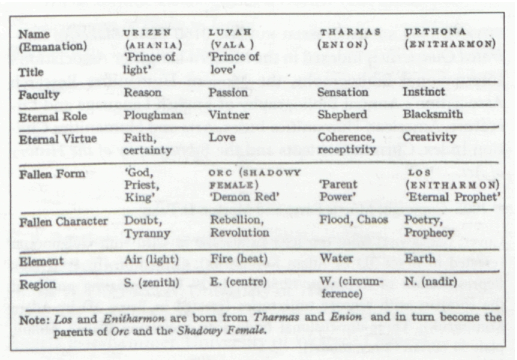
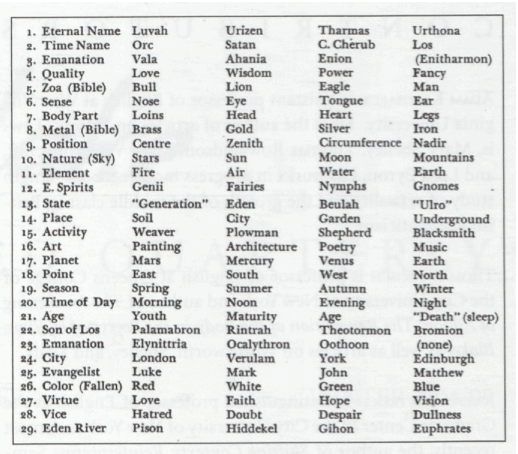
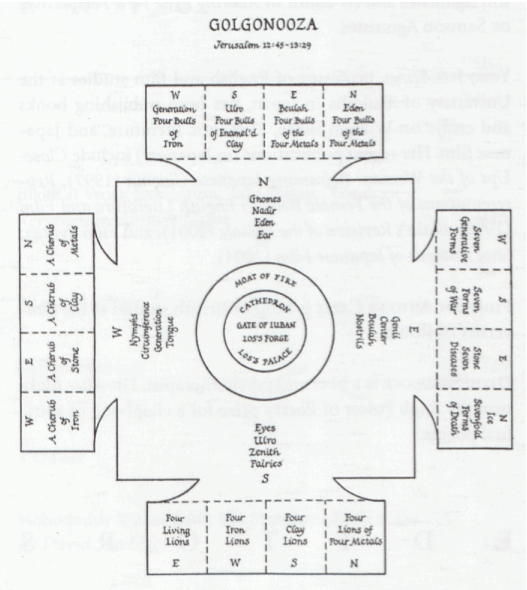
![Child
Emanation of
Aspect
Fallen form of
Albion
Jerusalem
Urizen Luvah Tharmas Urthona
Ahania Vala Enion Enitharmon
Los
Enitharmon
Satan Orc Rintrah Palamabron Theotormon Bromion Sotha
Shadowy Female Ocalythron Elynittria Oothoon Leutha Thiralatha/Diralada
Hand Hyle Bowen Gwantok Coban
Cambel Gwendolen Conwenna Cordella Ignoge
Rahab
Scofield [Adam] Hutton Slade Kox [Noah] Kotope Peachey Brereton
Gwiniverra Gwinefred Gonorill Estrild Sabrina Mehetabel Ragan
Tirzah
Adam Enoch Shem Han Japeth](img/illustrations/AlbionsFamilyTree.38.3.bqscan.png)
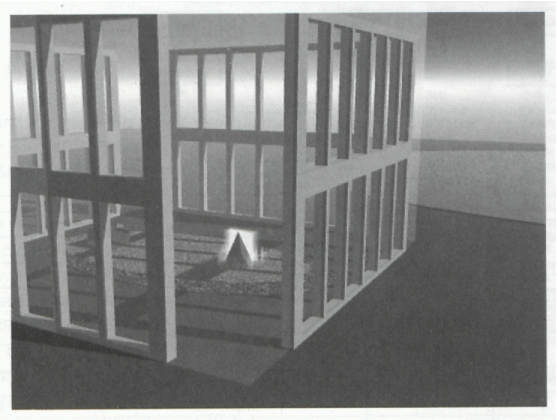
![BRITISH
M[USEU]M](img/illustrations/BB209.1.44.MS.detail.300.jpg)
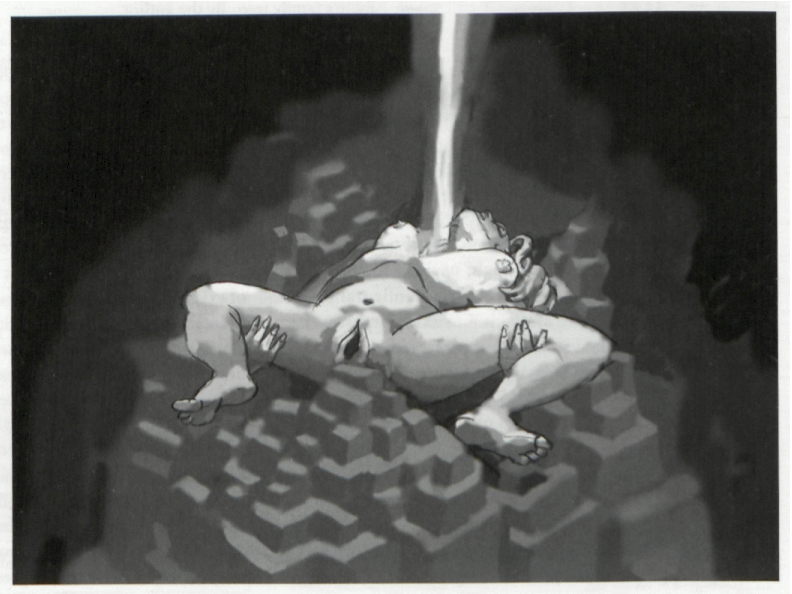

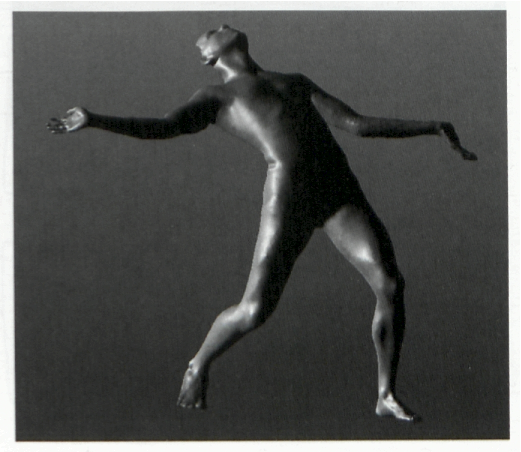
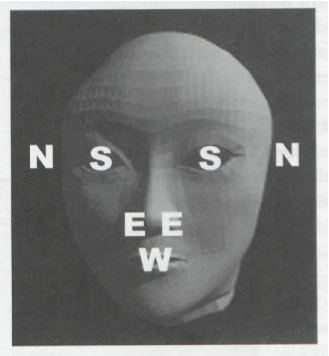

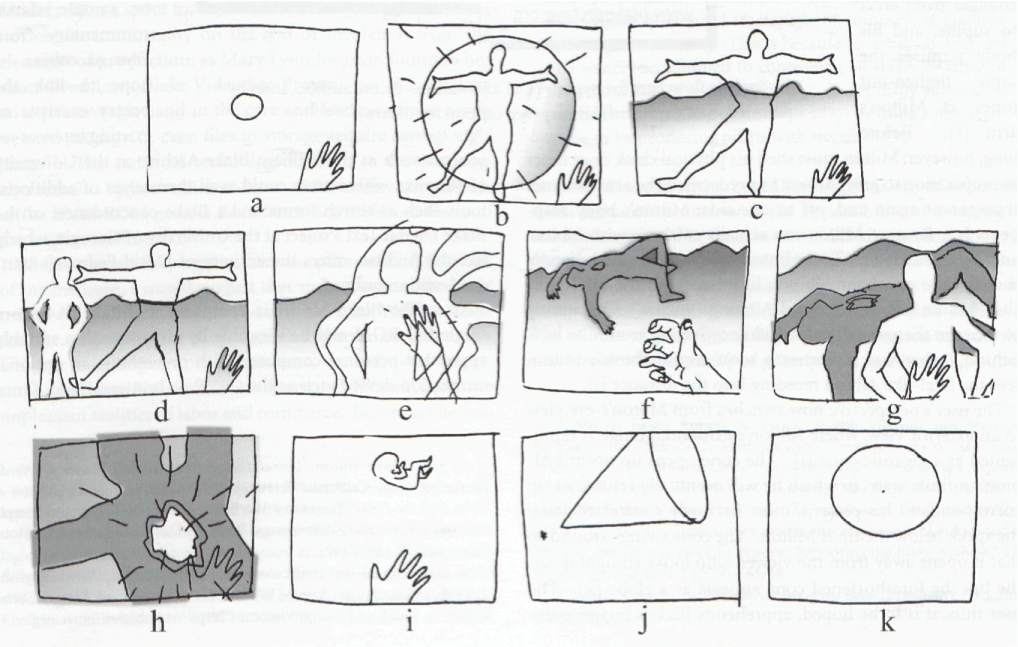
![Cathedron
A great hall that stands of the island of Luban within the city of Golgonooza. The name is a synthesis
of “cathedral” and Blake’s wife Catherine. It suggests the dual power of organized religion and feminine
sexuality to entrap the enlightened man.
William Blake, Jerusalem
William Blake, The Four Zoas [image]
Northrop Frye, Fearful Symmetry
A wondrous golden Building immense with ornaments sublime
Is bright Cathedrons golden Hall, its Courts Towers & Pinnacles
Jerusalem 59.25
www.blakearchive.org](img/illustrations/Flowchart.Hypertext.38.3.bqscan.png)